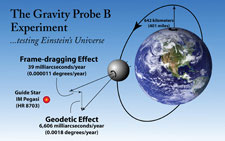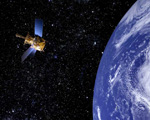WEEKLY UPDATE FOR 27 MAY 2005:
GRAVITY PROBE B MISSION STATUS AT A GLANCE

| Item | Current Status |
| Mission Elapsed Time | 402 days (57 weeks/13.18 months) |
| Science Data Collection | 273 days (39 weeks/8.95 months) |
| Current Orbit # | 5,933 as of 5:00 PM PST |
| Spacecraft General Health | Good |
| Roll Rate | Normal at 0.7742 rpm (77.5 seconds per revolution) |
| Gyro Suspension System (GSS) | All 4 gyros digitally suspended in science mode |
| Dewar Temperature | 1.82 kelvin, holding steady |
| Global Positioning System (GPS) lock | Greater than 98.0% |
| Attitude & Translation Control (ATC) | X-axis attitude error: 222.4 marcs rms |
| Command & Data Handling (CDH) | B-side (backup) computer in control Multi-bit errors (MBE): 0 Single-bit errors (SBE): 15 (daily average) |
| Telescope Readout (TRE) | Nominal |
| SQUID Readouts (SRE) | Nominal |
| Gyro #1 rotor potential | -0.9 mV (As of 5/26) |
| Gyro #2 rotor potential | -1.7 mV (As of 5/26) |
| Gyro #4 rotor potential | -1.4 mV (As of 5/26) |
| Gyro #3 Drag-free Status | Backup Drag-free mode (normal) |
MISSION DIRECTOR'S SUMMARY

As of Mission Day 402, the Gravity Probe B vehicle and payload are in good health. All four gyros are digitally suspended in science mode. The spacecraft is flying drag-free around Gyro #3.
The spacecraft has entered its third solstice or full-sun period of the mission. During these periods, the plane of the spacecraft's orbit is perpendicular with respect to the sun's position for about three weeks. Thus, the sun shines broadside on the spacecraft throughout each orbit around the Earth. As in previous full-sun periods, some fine tuning of various spacecraft systems is required to counter the effects of temperature increases in the Dewar shell and the electronics boxes mounted in the bays of the spacecraft frame.

Preliminary SQUID calibration signal tests, described in last week's Mission Director's Summary, are continuing. These tests do not affect the science data collection, but they help us evaluate the performance of the four SQUIDS relative to each other.
Also, development of procedures for the final set of instrument calibration tests that will occur in August, just before the liquid helium in the Dewar is exhausted, are continuing. Likewise, the plans for two full-day simulations, during which the Mission Operations Team will rehearse executing these procedures and work through any issues or problems, are being finalized.
MISSION NEWS—WHAT WILL ULTIMATELY HAPPEN TO THE GP-B SPACECRAFT?
 Over the past year, we've received a number of questions regarding the ultimate
fate of the GP-B spacecraft after the mission ends this coming September. These
questions include:
Over the past year, we've received a number of questions regarding the ultimate
fate of the GP-B spacecraft after the mission ends this coming September. These
questions include:
- Can the spacecraft be used to make any other measurements or perform any other kinds of experiments after the helium runs out?
- How long will the GP-B spacecraft continue to orbit the Earth? Can it be maneuvered after the helium runs out?
- Does NASA have any plans to retrieve the GP-B spacecraft and preserve it somewhere-such as the Smithsonian Institution's Air and Space Museum in Washington DC? Can the Space Shuttle retrieve the GP-B spacecraft?
- Can I get one of the gyros?
 Because these questions seem to be on many people's minds, it seemed appropriate
to discuss this whole topic in this week's Mission News.
Because these questions seem to be on many people's minds, it seemed appropriate
to discuss this whole topic in this week's Mission News.
The relativity measurements that Gravity Probe B is currently making require that the science gyros and SQUID magnetometer pick-up loops be maintained in a cryogenic environment, with all other sources of noise and disturbance either eliminated or minimized to insignificant levels. This environment had to be maintained from before launch through the Initialization and Orbit Checkout (IOC), science (data collection), and final instrument calibration phases of the mission. In other words, there needed to be enough liquid helium in the Dewar to last at least 14 months and preferably 16-20 months. This is the reason that the spacecraft needed a 650-gallon Dewar, the size of a cement mixer.
In addition to maintaining the cryogenic environment inside the Dewar, the liquid helium also provides a constant source of propellant that enables the micro thrusters to both keep the spacecraft and telescope pointed at the guide star and also maintain the spacecraft in drag-free flight, using one of the science gyros (currently gyro #3), as the spacecraft's center of mass or “proof mass.”
Recent measurements indicate that the liquid helium in the Dewar will be completely expended around the beginning of September. When this happens, the gyro rotors will continue to spin, but their niobium coatings will warm up and cease to be superconductive. Thus, the spinning gyro rotors will no longer generate magnetic moments around their axes of spin, and there will no longer be any signals for the SQUID magnetometers to readout. Moreover, there will no longer be any helium gas escaping from the Dewar to serve as propellant for the micro thrusters, so the spacecraft will cease to fly drag free in its orbit.
 Without drag-free flight and superconductivity in the gyros and SQUIDs, it
will no longer be possible to conduct further relativistic measurements
of the gyro's spin axes. However, the spacecraft's solar arrays will continue
to provide power for many years, and the NiCAD batteries on-board are rated
for a minimum of five years. While there would be no propellant for controlling
the attitude of the spacecraft using the micro thrusters, the spacecraft
has magnetic torquers, which can provide a small degree of attitude control.
Furthermore, the Gyro Suspension System (GSS) electronics will continue to
keep the gyros suspended, and if left untouched, the gyros would continue
to spin for thousands of years. The GSS can also be used to measure torques
or forces being exerted on the gyros.
Without drag-free flight and superconductivity in the gyros and SQUIDs, it
will no longer be possible to conduct further relativistic measurements
of the gyro's spin axes. However, the spacecraft's solar arrays will continue
to provide power for many years, and the NiCAD batteries on-board are rated
for a minimum of five years. While there would be no propellant for controlling
the attitude of the spacecraft using the micro thrusters, the spacecraft
has magnetic torquers, which can provide a small degree of attitude control.
Furthermore, the Gyro Suspension System (GSS) electronics will continue to
keep the gyros suspended, and if left untouched, the gyros would continue
to spin for thousands of years. The GSS can also be used to measure torques
or forces being exerted on the gyros.
Thus, the GP-B spacecraft could be used to provide other kinds of scientific data, such as measurements of variations in the Earth's shape. The decision as to whether or not to do this will ultimately be made by NASA, as a function of scientific interest, available funds, and agency priorities. There is no way that the Space Shuttle, when it begins flying again this July, could retrieve the GP-B spacecraft. All shuttle flights are launched from the Kennedy Space Center in Florida, out over the Atlantic, into equatorial orbits about 200 miles above the Earth. By contrast, GP-B is in a polar orbit, perpendicular to shuttle orbits, and it is orbiting 400 miles above the Earth. Thus, shuttle retrieval is not a possibility.
As an historical note, the original Space Shuttle program was scheduled to launch shuttles in both equatorial orbits (from Kennedy Space Center) and in Polar Orbits (from Vandenberg Air Force Base in California). Originally, GP-B was slated to be launched into orbit from the cargo bay of a shuttle in polar orbit. However, after the Challenger accident inn 1986, NASA did away with all plans for West Coast, polar orbiting shuttle launches. Thus, GP-B had to be re-designed as a satellite that could be launched from atop a rocket, rather than being deployed from the cargo bay of a Space Shuttle. Furthermore, even if GP-B had been deployed from a shuttle, it would have to have been boosted up to its 400 mile orbit, so the shuttle could not have retrieved it anyway.
If NASA chooses not to fund any further research uses of the GP-B spacecraft, then one of the final actions of the GP-B Mission Operations Team will be to spin down the gyros and then shut down all spacecraft systems, using a special double-safe shutoff procedure that ensures the spacecraft's computers and telemetry system will never spontaneously re-start themselves (which once happened with another satellite).



Once this procedure has been run on the GP-B spacecraft, it will basically become another piece of orbiting “space junk.” The spacecraft will continue to orbit the Earth for another 30+ years. Eventually, its orbit will decay, and it will re-enter the Earth's atmosphere and burn up. Most likely, the whole spacecraft will burn up, but if anything were to survive re-entry, it would undoubtedly be the quartz block, housing the four gyros. Thus, although very unlikely, it is conceivable that sometime in our grandchildren's generation, a fiery piece of space junk containing four of the roundest objects ever made may come crashing down in a field somewhere, and someone could bring one or more of the GP-B flight gyros to the Smithsonian Institution to keep for posterity.
UPDATED NASA/GP-B FACT SHEET AVAILABLE FOR DOWNLOADING
We recently updated our NASA Factsheet on the GP-B mission and experiment. You'll now find this 6-page document (Adobe Acrobat PDF format) listed as the last navigation link under "What is GP-B" in the upper left corner of this Web page. You can also click here to download a copy.
Drawings & Photos: The schematic diagram of the GP-B experiment, the drawing of the GP-B seasons, and the composite photos showing the GP-B spacecraft in orbit above the Earth were created with Adobe Photoshop by GP-B Public Affairs Coordinator, Bob Kahn. The photos of the SRE box, the Dewar, the quartz block, gyro assembly, and gyro rotor are from the GP-B Image Archive here at Stanford University. Click on the thumbnails to view these images at full size.
MORE LINKS ON RECENT TOPICS
- Track the satellite in the sky
- Photo, video & and news links
- Build a paper model of the GP-B Spacecraft
- Following the mission online
- Our mailing list - receive the weekly highlights via email
- The GP-B Launch Companion in Adobe Acrobat PDF format. Please note: this file is 1.6 MB, so it may take awhile to download if you have a slow Internet connection.
Previous Highlight
Index of Highlights
